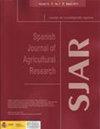坎塔布里亚用于草饲牛奶生产的潜在土地利用
IF 0.8
4区 农林科学
Q3 AGRICULTURE, MULTIDISCIPLINARY
引用次数: 0
摘要
研究目的:分析坎塔布里亚生产草饲奶的地域潜力。研究区域:坎塔布里亚(西班牙北部)是一个与牲畜有关的地区,特别是牛和草地。在过去几十年里,畜牧业一直处于结构调整的过程中,导致农场数量减少、规模扩大和生产集约化。此外,由于消费者对更健康和更环保的产品越来越感兴趣,市场上越来越多地供应标有“草饲”的牛奶。材料与方法:选取99个畜牧场,按泌乳奶牛春季饲粮中鲜草(非草饲:25%鲜草;草饲:≥25% FG);对这些特征进行了表征,随后进行了多元线性回归分析,以估计基于41个地域变量的FG百分比。 主要结果:预测饲养模型的准确率为70.7%,对非草饲奶有较好的判别能力,但存在一定的局限性,说明地域结构对草饲奶的判别很重要,但还不够。此外,33%的农场生产草饲牛奶,但只有一半的农场是在与这种生产典型相关的领土条件下生产的。同时,在土地条件相似的农场中,有12%的农场不进行这种生产(草饲)。研究重点:为了支持草饲生产,必须考虑到其他内部、文化或经济价值。本文章由计算机程序翻译,如有差异,请以英文原文为准。
Potential land use of Cantabria for grass-fed milk production
Aim of study: To analyse the territorial potential of Cantabria to produce grass-fed milk.
Area of study: Cantabria (N Spain) is a territory associated with livestock, in particular cattle and grasslands. Over the last few decades, the livestock sector has been immersed in a process of structural adjustment, leading to a reduction in the number of farms, an increase in their size and the intensification of production. Moreover, the market is being increasingly supplied with milk labelled “grass fed”, due to growing consumer interest in healthier and more environmentally friendly products.
Material and methods: To do this, 99 livestock farms were classified according to the percentage of fresh grass (FG) in the spring diet of the lactating cows (non-grass-fed: <25% FG; grass-fed: ≥25% FG); these were characterized and, subsequently, a multiple linear regression analysis was carried out to estimate the percentage of FG based on 41 territorial variables.
Main results: The predicted feeding model had an accuracy rate of 70.7%, and discriminated better the non-grass-fed, it had some limitations, suggesting that territorial structure is important but not enough to differentiate grass-fed milk. In addition, 33% of the farms studied produce grass-fed milk, but only half do so under territorial conditions typically associated with this type of production. Meanwhile, 12% of the farms, with similar territorial conditions, do not carry out this type of production (grass fed).
Research highlights: To support grass-fed production, other internal, cultural or economic values must be taken into account.
求助全文
通过发布文献求助,成功后即可免费获取论文全文。
去求助
来源期刊

Spanish Journal of Agricultural Research
农林科学-农业综合
CiteScore
2.00
自引率
0.00%
发文量
60
审稿时长
6 months
期刊介绍:
The Spanish Journal of Agricultural Research (SJAR) is a quarterly international journal that accepts research articles, reviews and short communications of content related to agriculture. Research articles and short communications must report original work not previously published in any language and not under consideration for publication elsewhere.
The main aim of SJAR is to publish papers that report research findings on the following topics: agricultural economics; agricultural engineering; agricultural environment and ecology; animal breeding, genetics and reproduction; animal health and welfare; animal production; plant breeding, genetics and genetic resources; plant physiology; plant production (field and horticultural crops); plant protection; soil science; and water management.
 求助内容:
求助内容: 应助结果提醒方式:
应助结果提醒方式:


